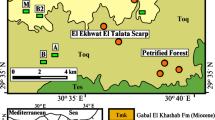Abstract
Concentrations of N, F, Na, Mg, Al, Si, P, K, Ca, Mn, Fe, Zn, Sr and Ba were determined in fossil bones using neutron activation analysis and X-ray fluorescence methods. Analysis of the data led to the conclusion that a correlation exists between the concentration of nitrogen and the temperature at the burial time of bones. This correlation enabled the temperature for different eras to be estimated. Correlation was also found between the Al, Si and Fe infiltered into the organic part of bones.
Similar content being viewed by others
References
J. Middleton, Proc. Geol. Soc. of London,4, 431, 1844.
I. Kiszely, Derivatographic research of subfossile bones, A Móra Ferenc Múzeum Évkönyve, 217, 1969.
H. Vonach, Fast Neutron Physics at the Institut für Radiumforschung und Kernphysik, ATOMKI Közlemények,18, 247, 1976.
Gy. Szőőr, Acta Mineralogica-Petrographica,22, 61, 1975.
P. Eisenbarth and P. Hille, J. of Radional, Chem.,40, 203, 1977.
P. H. Abelson, Geochemistry of Amino Acids, Organic Geochemistry (ed. I. A. Berger) International Series of Monographs on Earth Science,16, 431, 1963.
R. Protsch, Comparison of Absolute Bone Dates by Radiocarbon and Amino-Acid Dating on Upper Pleistocene Hominids, UISPP IX. Congress, Nice 1976, p. 180–211.
S. F. Cook and R. F. Heizer, Am. Antiquity,4, 354, 1953.
K. P. Oakley, Bulletin of the British Museum (Natural History), Geology Series,34, 1, 1980.
Cs. M. Buczkó, Nukleáris módszerek alkalmazása fosszilis csontok elemösszetevőinek meghatározására, (Use of nuclear methods for the determination of chemical composition of fossil bones). Thesis, Debrecen, 1978 (in Hungarian).
Cs. M. Buczkó and L. Vas, Nature,269, 792, 1977.
Cs. M. Buczkó, J. Nemeskéry and L. Vas, Age Dating of Bones from Vlasac Based on their Nitrogen and Fluorine Contents, VLASAC a Mesolithic Settlement in the Iron Gates, Vol.II. p. 75–76, Geology-Biology-Anthropology, Beograd, 1978.
D. E. Sugden and B. S. John, Glaciers and Landscape, London, 1976.
H. Flohn, Stehen wir vor einer Klima-Katastrophe?, Umschau77, Heft 17, 1977.
P. Ambrózy, R. Czelnai and G. Götz, Fizikai Szemle,27, 54, 1977 (in Hungarian).
Rh. W. Fairbridge, Phys. and Chem. of the Earth,4, 99, 1961.
M. Járai-Komlódy, Botanikai Közlemények,58, 131, 1971 (in Hungarian).
C. E. P. Brooks, Climate Through the Ages, London, 1950.
Cs. M. Buczkó, N. I. Ilkov, A. Borbély, Radiochem. Radioanal. Letters,35, 175, 1978.
E. Nemecz, Agyagásványok, (Clay Minerals), Akadémiai Kiadó, Budapest, 1973 (in Hungarian).
H. I. M. Bowen, Trace Elements in Biochemistry, London, 1966.
Author information
Authors and Affiliations
Additional information
Dedicated to Prof. I. Tarján on his 70th birthday.
Rights and permissions
About this article
Cite this article
Buczkó, C.M., Csikai, J. & Nemeskéry, J. Application of nuclear methods in paleosciences. Acta Physica 53, 165–178 (1982). https://doi.org/10.1007/BF03156187
Issue Date:
DOI: https://doi.org/10.1007/BF03156187




